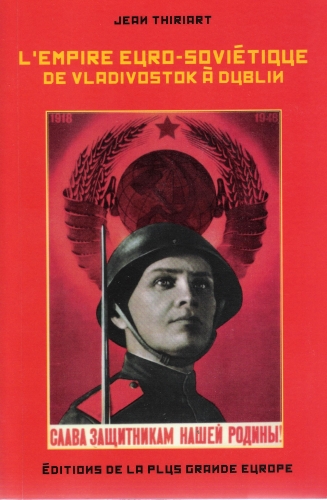Il est rare qu’un ouvrage ou plus exactement un brouillon inachevé paraisse chez deux éditeurs différents à peu près à la même date. C’est le cas pour cet essai géopolitique de Jean Thiriart dont une première version est parue chez Ars Magna dans l’excellente collection « Heartland ». Rédigé en 1983 – 1984 et mis en forme par Yannick Sauveur, cet ouvrage esquisse la vision grande-continentale du fondateur de Jeune Europe.
Face au regain de guerre froide dans les années 1980, conséquence de l’arrivée à la Maison Blanche du cow boy de bac à sable Ronald Reagan, Jean Thiriart réfléchit à l’éventuel et souhaitable alignement d’une Europe fracturée en États plus ou moins rivaux sur l’URSS alors au faîte de sa puissance. Il considère en effet qu’après les échecs de Charles Quint, de Napoléon Bonaparte et d’Adolf Hitler, l’Union Soviétique doit devenir le meilleur acteur du processus d’unification à venir. Parce que « l’URSS est aujourd’hui la dernière nation indépendante en Europe (p. 29) », il estime nécessaire qu’« un passage du communisme à plus de rationalité (et, dès lors, d’efficacité) est indispensable au Kremlin s’il veut digérer, assimiler l’Europe occidentale (p. 29) ». Jean Thiriart encourage par conséquent l’expansion de l’URSS à l’ensemble du continent européen. Il regrettera au soir de sa vie que l’Union Soviétique n’ait pas annexé à l’instar des États baltes la Bulgarie, la Pologne ou la Hongrie ainsi que les autres États membres du Pacte de Varsovie. Il approuva l’intervention de l’Armée rouge en Afghanistan à la fin de l’année 1979. Il a très tôt compris les connivences complexes entre la subversion américaniste et l’islamisme. Bien avant d’autres essayistes, il avait fait de l’« Islamérique » son ennemi principal.
Jean Thiriart devine déjà les prémices de l’« après-Yalta (p. 31) » et formule le vœu que « si le Kremlin réalise une grande république à vocation impériale, c’est par milliers que des hommes de l’Élite ouest-européenne porteront volontairement la casquette à étoile rouge, sans hésitation (p. 35) ». Il y a ici une convergence intéressante avec la conclusion polémique d’Orientations pour des années décisives d’Alain de Benoist écrite en 1983. Cet engouement pour l’Union Soviétique n’est ni romantique, ni national-bolchevik ! Pragmatique, Jean Thiriart prône « une “ doctrine Monroe ” pour l’Europe (p. 146) », défend une réunification coréenne favorable aux intérêts euro-soviétiques et propose à l’échelle planétaire « la mise en place de quatre blocs […] (Chine, Indes, Empire euro-soviétique et Amériques) (p. 135) ».
 Dans cette ambitieuse perspective géopolitique, il dénonce bien sûr l’influence du sionisme en Europe et s’inquiète de la prolifération prochaine des lois liberticides. Il consent cependant à ce que l’Europe unifiée et libérée de l’emprise atlantiste protège « un “ petit ” Israël bucolique (frontières décrites par l’ONU) […]. Par contre, la paranoïa biblique d’extrême droite qui rêve du grand Israël jusqu’à l’Euphrate doit être dénoncée et combattue avec vigueur (p. 108) ». Cette approche ne doit pas surprendre. L’auteur a toujours revendiqué la supériorité de l’omnicitoyenneté politique sur les appartenances communautaires linguistiques, religieuses et ethniques. « La citoyenneté euro-soviétique ou grand-européenne doit devenir ce qu’a été la citoyenneté romaine (p. 237). » On comprend mieux pourquoi Alexandre Douguine s’en réclame bien que les deux hommes divergeaient totalement sur le plan spirituel. La République euro-soviétique de Thiriart serait une Fédération de Russie élargie à l’Eurasie septentrionale.
Dans cette ambitieuse perspective géopolitique, il dénonce bien sûr l’influence du sionisme en Europe et s’inquiète de la prolifération prochaine des lois liberticides. Il consent cependant à ce que l’Europe unifiée et libérée de l’emprise atlantiste protège « un “ petit ” Israël bucolique (frontières décrites par l’ONU) […]. Par contre, la paranoïa biblique d’extrême droite qui rêve du grand Israël jusqu’à l’Euphrate doit être dénoncée et combattue avec vigueur (p. 108) ». Cette approche ne doit pas surprendre. L’auteur a toujours revendiqué la supériorité de l’omnicitoyenneté politique sur les appartenances communautaires linguistiques, religieuses et ethniques. « La citoyenneté euro-soviétique ou grand-européenne doit devenir ce qu’a été la citoyenneté romaine (p. 237). » On comprend mieux pourquoi Alexandre Douguine s’en réclame bien que les deux hommes divergeaient totalement sur le plan spirituel. La République euro-soviétique de Thiriart serait une Fédération de Russie élargie à l’Eurasie septentrionale.
Admirateur des « Hussards noirs de la IIIe République » et d’Atatürk, il réaffirme son unitarisme politique foncier. Il faut en tout cas saluer l’initiative qui permet à de nouvelles générations de découvrir ce document passionnant.
Georges Feltin-Tracol
• Jean Thiriart, L’empire euro-soviétique de Vladivostok à Dublin, préface de Yannick Sauveur, Les Éditions de la plus grande Europe, 2018, 337 p., 25 €.





 del.icio.us
del.icio.us
 Digg
Digg